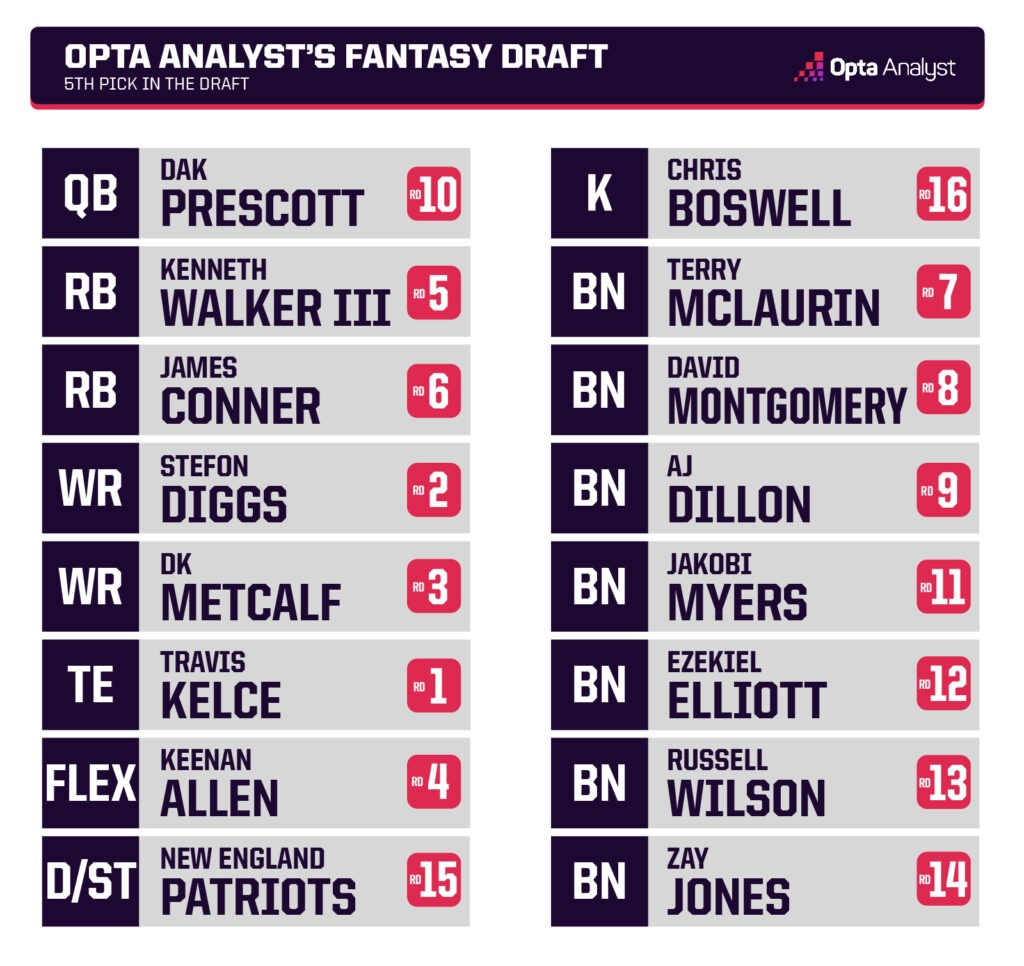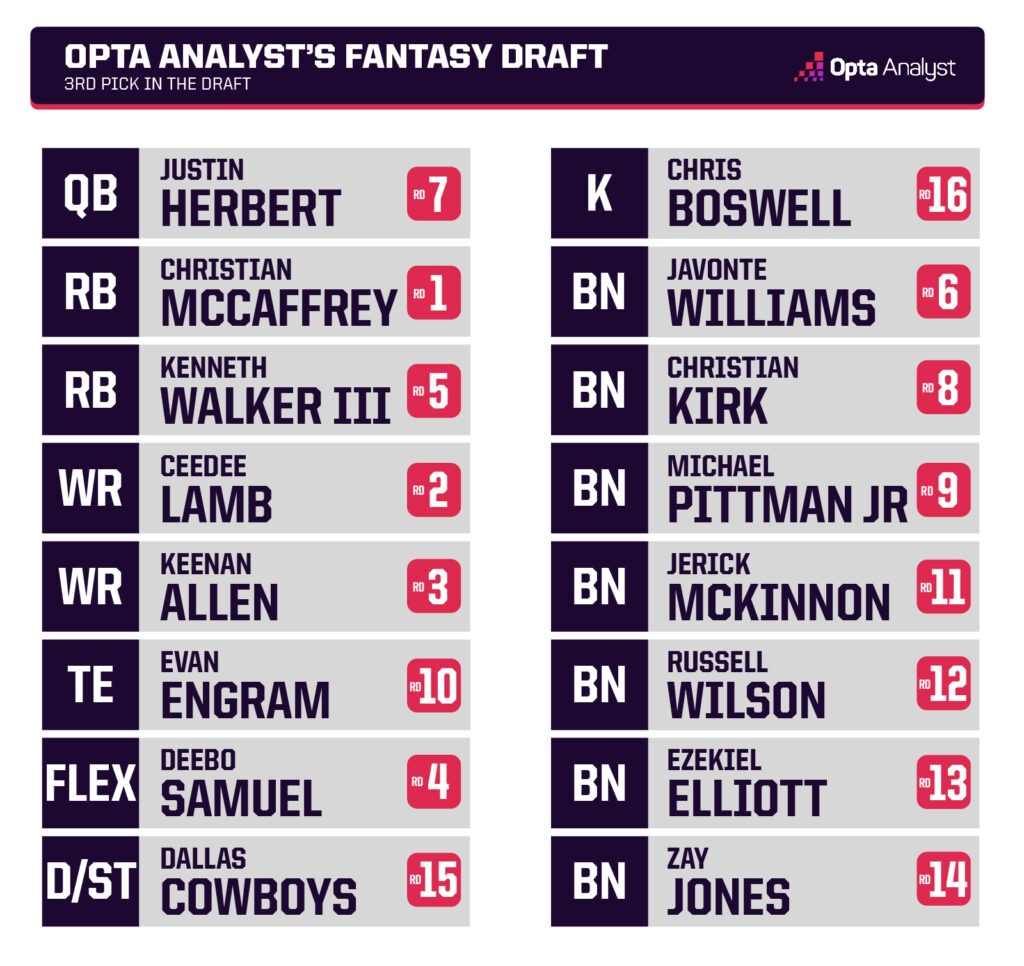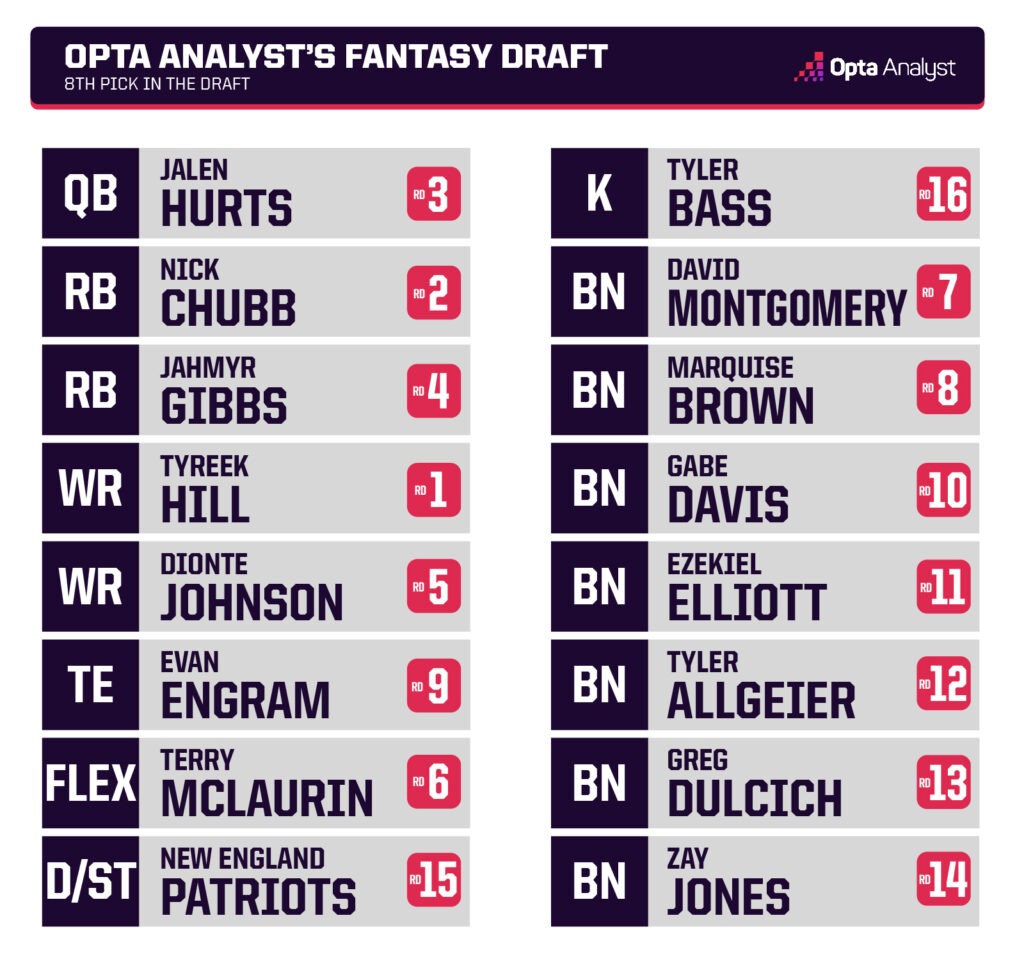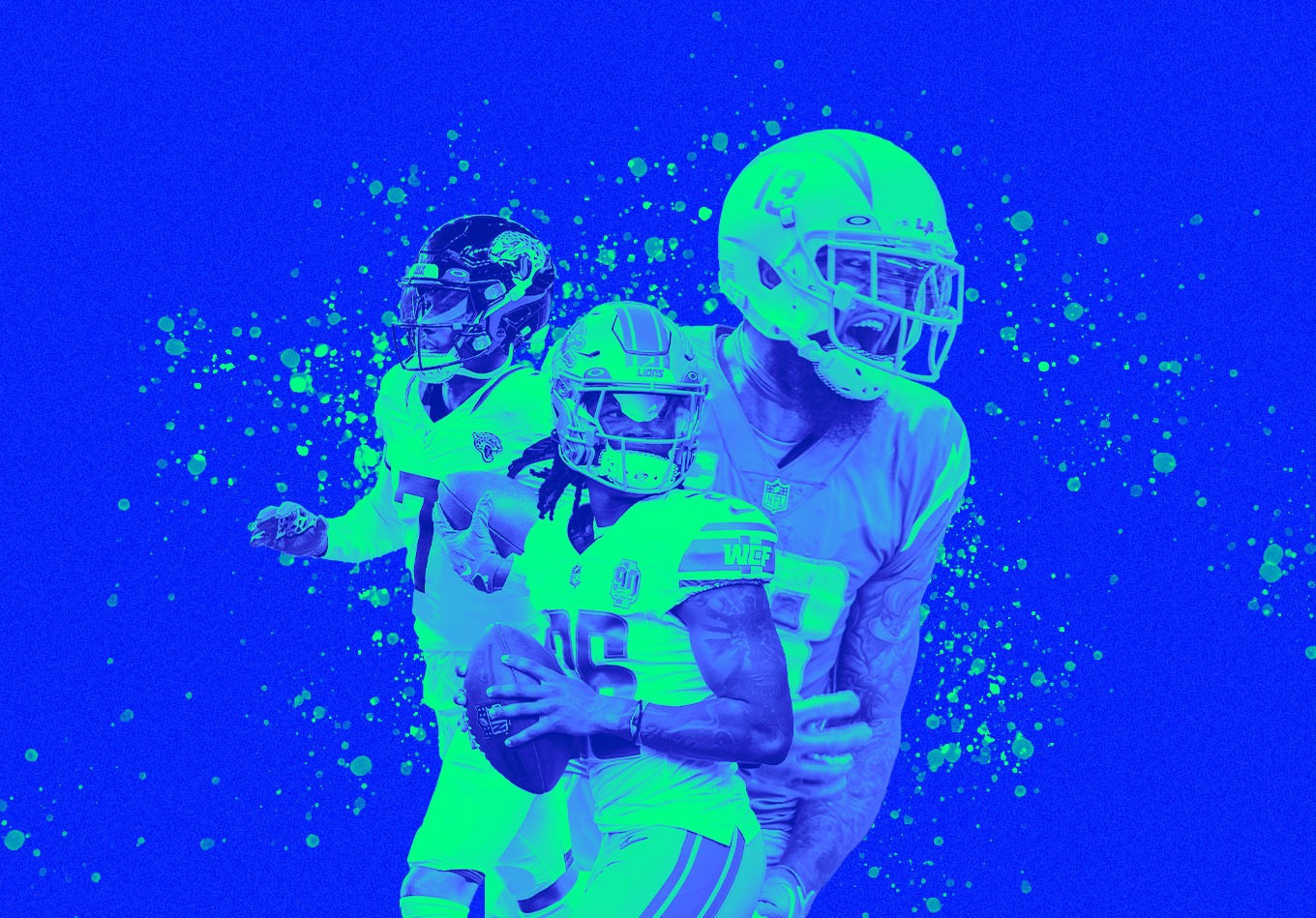Summer vacations are in the rearview, school is back in session, and El Segundo, California, just won an epic LLWS Championship game.
All that can only mean one thing… football is officially back!
For those of you who haven’t drafted yet, fantasy football mock drafts have suddenly become your best friend over the last couple of weeks as the preseason has run its course. And it’s no different for us. For the first time this year, we decided to take our model and test it out by running it through the mock draft ringer to see what a team would look like if we drafted purely using a cheat sheet of our rankings.
No gut feelings, no worries about bye weeks, and no biases against our least favorite teams. These are five things we learned while doing eight different, 10-team, full point-per-reception (PPR) mock drafts.
Note: Our model is constantly updating as new information comes out, these mock drafts were all done using our rankings as of Aug. 27.
1) It feels only right to start with our No. 1 player as of now. Within the industry, Justin Jefferson seems to have a firm grasp of the top spot, but our model has identified a player at a different position, someone nine years his senior and with a highly entertaining podcast, as the top player overall: Travis Kelce. There is no greater advantage in fantasy than having Kelce on your football team. To that end, our model projects Kelce to be almost 80 points better than TE2 – a significantly higher margin than any other position.
We happily selected Kelce in the first round every time we could, which for us occurred when we selected second, fourth, and fifth (he was selected second in our trial run out of the third spot, more on that draft later).
When we couldn’t get Kelce in the first round, we tended to wait a little longer for the tight end position, targeting two players with a lower overall ADP on Fantasy Pros (FPros), but ranked very highly by our model: Dallas Goedert (our TE2, TE7 on FPros) and Evan Engram (our TE4, TE8 on FPros).
Goedert, in particular, is a favorite of our model as his role in the Philadelphia Eagles’ RPO-heavy offense leads to a lot of opportunity. Combined with the Eagles’ lack of penchant for throwing to their running backs – only 48 receptions by Eagles backs all last season – Goedert is in line for a big season and finds himself above fantasy tight end stalwarts like Mark Andrews, George Kittle, and T.J. Hockenson.
2) As has been the case for years now, our model prefers wide receivers with a profile that suggests they’re likely to receive heavy volume. A player going outside the top 25 in drafts that our model thinks is undervalued is Keenan Allen of the Los Angeles Chargers. We selected him in an astounding seven of the eight mock draft exercises in either the third or fourth round.
There are reasons that Allen is slipping down drafts – age, a new offensive coordinator, a new first-round rookie wide receiver, and injuries – but all that does is obscure just how excellent he was the second half of last season. Here’s the entire list of players who scored more PPR points than Allen from Weeks 11-18 last season: Jefferson and Davante Adams.
Add Stefon Diggs to a team with Allen and Kelce, and from the fifth spot, your team can look something like this.

One note on this draft: Even though we started with Kelce and Diggs, once Metcalf fell to us in the third and Allen in the fourth, despite having needs at running back, we felt the opportunity to pass up having three of the model’s top 12 wide receivers in addition to Kelce was too strong to pass up.
3) What made that particular mock draft unique was that it was one of only two in which we didn’t end the draft with one of our model’s top five quarterbacks: Jalen Hurts of the Philadelphia Eagles, Josh Allen of the Buffalo Bills, Patrick Mahomes of the Kansas City Chiefs, Justin Fields of the Chicago Bears or Justin Herbert of the Chargers.
Unlike in previous seasons, when it was commonplace to wait on a quarterback as part of your draft strategy, it might be smarter to abandon that plan this year. Earlier, when we mentioned that Kelce is the biggest advantage in fantasy football, well Hurts, Allen and Mahomes aren’t far off.
Hurts, who finished third among that trio last season, outscored Geno Smith (QB5) by 70 points in 2022. It is a remarkable advantage to have one of those QBs, and if you’re not lucky enough to nab one, it’s imperative that you grab a QB that has mobility and upside.
This is what we did in grabbing Herbert when we did our mock exercise at pick No. 3. After Kelce was nabbed in front of us, we made the decision to select the model’s top running back, Christian McCaffrey, ahead of the likes of Austin Ekeler, Josh Jacobs, Derrick Henry and others, to build our team around. We were happy to grab Dallas Cowboys wideout CeeDee Lamb, who figures to be Dak Prescott’s top target, with our second-round selection over receivers like Amon-Ra St. Brown, Jaylen Waddle and A.J. Brown.

As quarterback play in the NFL shifts from traditional pocket passers (e.g. Tom Brady, Drew Brees, Peyton Manning) to dual-threat players (e.g. Lamar Jackson of the Baltimore Ravens, Fields, Anthony Richardson of the Indianapolis Colts), having a QB who can run becomes critical in 2023 fantasy football. That’s why you’ll find quarterbacks like Kirk Cousins of the Minnesota Vikings, Aaron Rodgers of the New York Jets, Derek Carr of the New Orleans Saints and Tua Tagovailoa of the Miami Dolphins all outside our top 10 at the position.
It doesn’t need to be the hallmark of a player’s ability, but if you’re deciding between two players like Russell Wilson and Geno Smith, Smith’s additional willingness to rush the ball can be the tiebreaker. Same when deciding between players like Jared Goff and Daniel Jones.
4) One commonality between the two drafts so far? You’ll find Zay Jones on both rosters, and he’s the only player we selected in all eight trial runs. He is, by far, the model’s most favorite late-round sleeper. He is ranked higher in our projections than some borderline Pro Bowl-type receivers, including Tyler Lockett, Brandon Aiyuk, Mike Evans and a host of others.
If that seems odd because Calvin Ridley is there to snatch targets, well, consider this: Chris Olave, Garrett Wilson, DeVonta Smith and Deebo Samuel are just a sampling of the players that Jones outscored in PPR points per game during the fantasy football regular season (Weeks 1-15) last year. He accomplished that while Christian Kirk was accumulating a top-10 total during that time span as well.
The Jaguars enter the year as one of the most fantasy-friendly offenses in football after three players caught 70 or more passes last year. Jones was one of them, and after seeing at least five targets in 13 of his 16 games, the model thinks there’s enough opportunity to make him an extremely worthy flyer later in drafts.
In our infatuation with younger, more dynamic players, one other steady veteran that the model projects to have a good season is Jerick McKinnon. Mahomes is still the QB, but other than Kelce, who’s going to be catching passes for the Chiefs this year?
Well, McKinnon averaged more than five targets per game from Week 9 onwards last season and was RB5 in PPR formats during that stretch. His ADP on FPros right now is 121, with 38 running backs coming off the board before him.
5) Quick recap: Our model prefers high-volume players, offenses that have proven themselves to be fantasy-friendly in the past, and if possible, one of the elite quarterback options. With that in mind, we present our favorite mock draft of the entire exercise, coming out of the eighth position.

Tyreek Hill, our No. 1 overall receiver just in front of Jefferson and Ja’Marr Chase, falling to us in the first round was gold, and our good luck carried over to the second round where we were happy to snatch up Nick Chubb. So we selected the player with the second-most receptions and receiving yards last year eighth overall before picking the player with the third-most carries and second-most rushing yards and touchdowns since entering the league in 2018. It was Chubb’s track-record that led to us selecting him over Tony Pollard and Saquon Barkley.
With the core of our team a perfect combination of high-floor and high-ceiling guys, and with Hurts in tow, what made this our favorite draft was a quite unique stack.
The Detroit Lions last year were a fantasy dreamland, a high-scoring combination of good offensively and horrific defensively. They had the league leader in rush touchdowns (Jamaal Williams with 17) and their second-leading receiver in catches was DeAndre Swift. Neither back remains on the roster, as they were replaced by electrifying rookie Jahmyr Gibbs and veteran David Montgomery.
We usually think of stacking as players at different positions, but in an offense that looks quite explosive entering the year, it’s more than reasonable to think that both can reach RB2 status due to their complementary skill sets – Gibbs in the passing game and Montgomery as more of a short-yardage and goal-line back. While Gibbs will cost you a higher pick, Montgomery can be nabbed in the same range as the Pittsburgh Steelers’ Najee Harris and the New England Patriots’ Rhamondre Stevenson.
In total, we ended up with three of our top 18 running backs, four of our top 24 wide receivers, our top quarterback and our TE4 in this draft. If that’s how you come out of your real draft, you’ll be a happy fantasy manager.
Like this? Follow us on Twitter for more.
